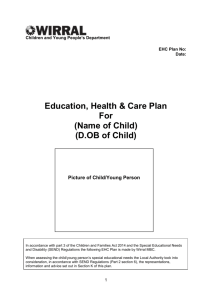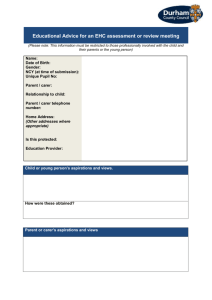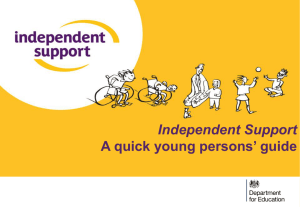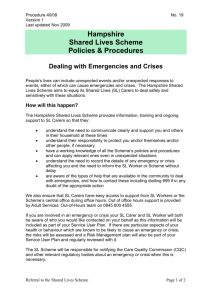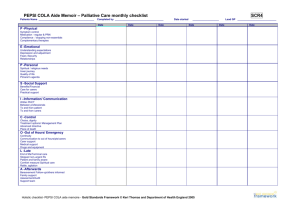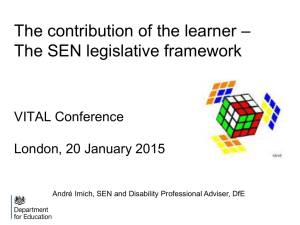Annex 3 - Hampshire County Council
advertisement
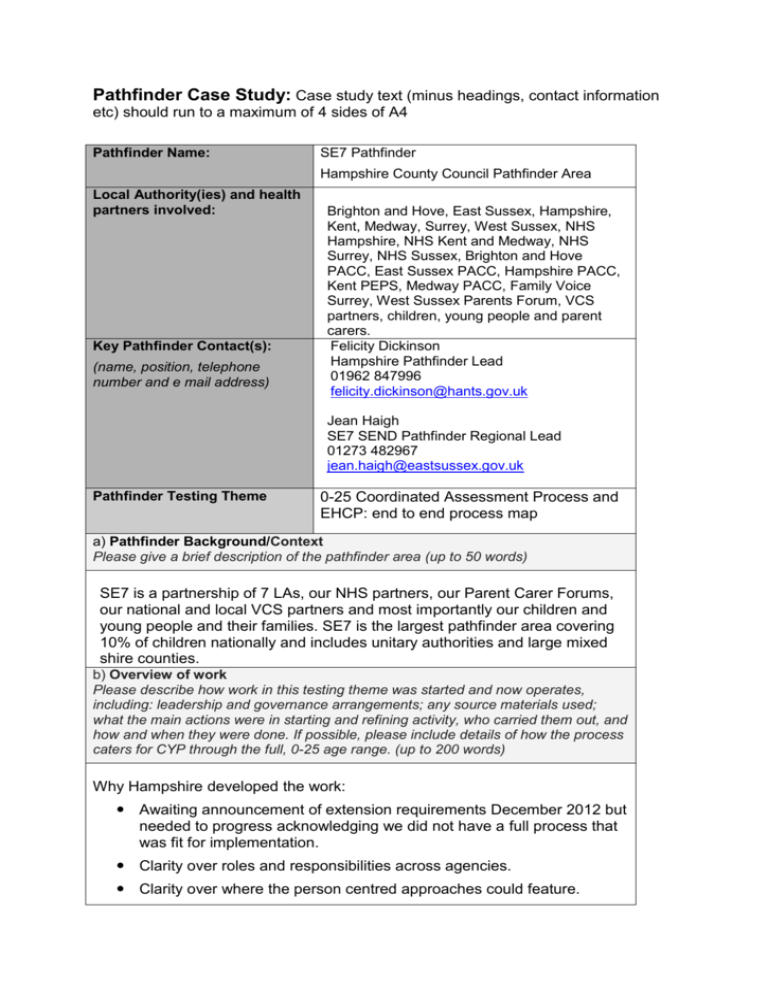
Pathfinder Case Study: Case study text (minus headings, contact information etc) should run to a maximum of 4 sides of A4 Pathfinder Name: SE7 Pathfinder Hampshire County Council Pathfinder Area Local Authority(ies) and health partners involved: Key Pathfinder Contact(s): (name, position, telephone number and e mail address) Brighton and Hove, East Sussex, Hampshire, Kent, Medway, Surrey, West Sussex, NHS Hampshire, NHS Kent and Medway, NHS Surrey, NHS Sussex, Brighton and Hove PACC, East Sussex PACC, Hampshire PACC, Kent PEPS, Medway PACC, Family Voice Surrey, West Sussex Parents Forum, VCS partners, children, young people and parent carers. Felicity Dickinson Hampshire Pathfinder Lead 01962 847996 felicity.dickinson@hants.gov.uk Jean Haigh SE7 SEND Pathfinder Regional Lead 01273 482967 jean.haigh@eastsussex.gov.uk Pathfinder Testing Theme 0-25 Coordinated Assessment Process and EHCP: end to end process map a) Pathfinder Background/Context Please give a brief description of the pathfinder area (up to 50 words) SE7 is a partnership of 7 LAs, our NHS partners, our Parent Carer Forums, our national and local VCS partners and most importantly our children and young people and their families. SE7 is the largest pathfinder area covering 10% of children nationally and includes unitary authorities and large mixed shire counties. b) Overview of work Please describe how work in this testing theme was started and now operates, including: leadership and governance arrangements; any source materials used; what the main actions were in starting and refining activity, who carried them out, and how and when they were done. If possible, please include details of how the process caters for CYP through the full, 0-25 age range. (up to 200 words) Why Hampshire developed the work: Awaiting announcement of extension requirements December 2012 but needed to progress acknowledging we did not have a full process that was fit for implementation. Clarity over roles and responsibilities across agencies. Clarity over where the person centred approaches could feature. Fit with Indicative Draft Code of Practice and Regulations (published March 2013). What would be different to the current approach? How the work was developed: Reflected on phase one in Hampshire. Applied known information from the Bill and Emerging Principles in December 2012, and then with the Regulations and Indicative Draft Code of Practice when they were published in March 2013. Held five multi-agency workshops with key stakeholders so approx 20 per workshop. These included at all workshops parent carers, health, social care, special education, schools (mainstream and special), parent partnership, education psychology and the voluntary and community sector. Applied the following principles to develop the process: Key working approaches Person centred planning Multi-agency collaboration Early opportunities to resolve disagreements “Tell it once” Developed the process from inception to completion over the course of the workshops, using an iterative approach: SEN Early Years Transition Health Overall Workshops evolved the process with healthy challenge across all stakeholder representatives. Process map developed by the Pathfinder Project Manager using the software application Microsoft Visio. Next steps: Testing the process from September 2013 within the age ranges 4-11 and 16-19. The EHC process will inform future work regarding the s139a Learning Difficulty Assessment transition in to the EHCP format. The following materials will be used: Parental and professional guidance materials. “Our Story” format to capture the family views. “My Story” format to capture the child or young person’s views. From January 2014 all new requests for a statutory assessment from birth to age 25 will be offered the opportunity to trial the EHCP process. The process map will evolve and be informed by the trial process. Further work is being undertaken on ways of working behind the business process, examining integration potential across agencies, the potential use of technology as this is currently a very paper based process and the use of key working/assessment co-ordinators. c) Consultation and Coproduction Please describe how parent carers and CYP, as well as educational settings, have been engaged in developing work in this theme. This should include the contribution of professionals across education (including those from educational settings), health and social care; how partners in the activity experienced the coproduction process at the time and what feedback has been to this way of working (up to 100 words) As in section b) above. These stakeholder groups were a part of the whole process in developing and evolving the process map throughout its development. Stakeholders valued the opportunity to participate and contribute, as well as further appreciate the implications and issues related to the forthcoming changes across the stakeholder groups. As this was a group process there are some areas where challenge still exists: Integration is not clearly evident within the process map itself, hence further work is being undertaken as it is felt that this will occur more in the way people work behind the process rather than be clear in the pure business process map itself. A lack of a clear definition of outcomes and how we can achieve consistency across Agencies in their specification of outcomes within the EHCP. We are producing a discussion paper on defining outcomes, using Preparing for Adulthood reference material, to help develop this area. The trial will further inform how this process works with: A shorter timescale of 20 weeks. Increased person centred and face to face meetings with parents, carers, children and young people. Reduced resources and people with the forthcoming 2015 budget cuts. Achieving the specification of quality and consistent outcomes across agencies. The highly devolved Health landscape and working consistently with a range of Health providers across a large County where agencies area boundaries are not co-terminous. The requirement for a “sign off” from Health providers for any health provision specified within the EHCP. Different approaches and formats within different local authority areas – the border issues are significant for Health and the Local Offer. The transition to college settings and moving in to Adult Services from Children’s Services. Those young people who leave education/training and then after a period of time decide to return to education/training and the validity of the EHCP. e) Wider communications Please describe how you are keeping parent carers, CYP, and educational settings up to date with progress in this thematic area, and any guidance on involvement in this strand of pathfinder work. If possible, please also outline how you are preparing these groups for full implementation. (up to 100 words) Hampshire Parent/Carer Network (HPCN) is working with Hampshire County Council to ensure parents/carers are involved at all stages of the Pathfinder. Two parent/carer representatives are involved in each of the work areas to contribute and provide feedback from the wider parent/carer audience. They are involved in trials for the new EHCP, Personal Budgets and co-producing the Local Offer. The EHCP workstream within Hampshire includes all key stakeholders. The group meets on a regular basis and this includes two parent/carers, educational settings and the voluntary and community sector as well as all the agencies. Raising awareness events are planned for the Autumn of 2013, along with letters to be sent inviting families to participate in the trial. As the trial progresses the findings and implications will be shared and discussed with the workstream, the Core Project Team and the multi-agency Change Board. All key stakeholders are represented within all these groups. f) Lessons Learned Please provide details of key lessons learned, challenges and how they were overcome, and the most important points to consider (where possible, in bullet point format). Of particular value, are lessons learned about scaling up testing to prepare for full implementation. These points should enable non-pathfinder areas to learn from the experiences of your pathfinder (up to 200 words) The lessons learned regarding the end to end process will come from the trial process over the next six to nine months. Co-production and working inclusively with stakeholder groups promotes an open and transparent process and approach encouraging participation and a healthy debate across stakeholder groups. The key challenges are: The moving landscape of the Bill, Regulations and Code of Practice and having to scale up for implementation without knowing the end requirements as these could significantly change over the forthcoming year. Parent/carers expectations: They have stated that they have a strong desire for one story, one process, one overall agreement of outcomes, and one overall agreement of provision/personal budget to meet the outcomes. They feel that the proposed process map does not deliver this currently. This also links to personal budgets – Hampshire has focused on children’s social care and an associated RAS – they want one holistic RAS across the three agencies. They feel that the three agencies appear to be continuing to work in their silos. The business innovation work that Hampshire is commencing will help inform the EHCP and parent/carer concerns. We are examining data and metrics, georgraphical locations and the potential for integrated working; conducting reference site research to determine how others have overcome the challenges of the EHCP and personal budgets; and commissioning some IT work to explore the potential for the use of technology to further enable the process. g) Supporting Materials Where appropriate, please provide or signpost the reader towards example materials such as anonymised EHCPs, high level statements about core content of different themes and key principles; communications materials, tools used for wider consultation etc. Of particular interest are diagrams that can be used within the Information Packs. Where relevant, please also include any testimonials or survey evidence from those who have been involved in the development of single assessment process or have completed EHCPs. The following diagram is best printed in A3. This is the summary page. The detailed process map is seven sides of A3. The pdf file will be attached to this case study for further information. It is the detailed process map that stakeholders have developed, the summary has been drawn from the detail as a one-page overview. Education, Health and Care Needs Assessment and Plan One Page Summary Draft Ideal Business Process Map Version 5 – for EHCP Trial As at 28 June 2013 LOCAL OFFER LOCAL OFFER www.hampshirelocaloffer.info (live first data end July 2013) Whole process underpinned by effective Local Offer enabling parent/carers, children and young people to navigate, search and understand services available and how to access them across education, health and children and adults social care. This includes mainstream and specialist services. SEN Team co-ordinate the compilation of “OUR STORY” with the family (parent/carers and children and young people). Offer face to face, letter, email, phone. Understand family circumstances, collate existing evidence/ information, explain next steps. Question: who to do this with family? REQUEST Consider need to facilitate deeper discussion between relevant provider/parent/child/young person how needs could be met from local offer as considered special educational needs could be met from within mainstream provision. Record meeting. Gather/request sufficient quality up-to-date information from education provider. Ensure Our Story received. Decision not to assess SEN Team: Is an EHC needs assessment appropriate? No Yes Ring parent/carer/young person to advise that the LA is securing an EHC needs assessment, determine the extent of face to face involvement they prefer, and advise of next steps. Confirm in writing to professionals and parent/carer/ young person. ASSESS Send out “Our Story” including evidence/information obtained to professionals and request sufficient, quality, upto-date assessments. APPEAL POINT Decision not to assess/Decision to assess (latter not in current requirements–DfE reviewing) Obtain mediation certificate Proceed with appeal to first-tier tribunal Time delay awaiting professional assessments of the child/young person SEN Team co-ordinate and compile the outcomes of the EHC needs assessment with close liaison with the parent/carers/ child/young person EHC needs assessment complete - notify parent/carer/ young person of outcomes of the needs assessment and if they propose to secure a statutory or non-statutory EHC Plan for the child/young person. STATUTORY EHC PLAN TO BE PROVIDED Disagreement resolution may be required between the parent/carer and young person if they cannot agree at this point Produce working draft of EHC Plan on basis of EHC needs assessment with parent/carers/child/young person. Whilst name/type of education provider cannot be stated informal discussion regarding preferences with the parent/carer/child/ young person is useful at this point. PLAN Time delay awaiting parent/carer/young person representations Compile non-statutory EHC Plan (review here in Hampshire of current Note-in-Lieu and Inclusion Partnership Agreement) with parent/ carer/young person and education provider agreeing outcomes to meet needs in the context of SEN normally available within the education setting. Send out to parent/carer/young person and education provider. APPEAL POINT Decision not to produce EHC Plan Obtain mediation certificate Proceed with appeal to first-tier tribunal 15 working days for education providers to respond to consultation Consult education provider(s) – parent/carer/young person requested and/or LA recommended. Write to parent/carer/ young person to inform them of education provider(s) being consulted Ring parent/carer/young person to advise of decision, options, what to expect and right to appeal to first-tier tribunal. Time delay awaiting education provider responses Determine appropriate education provider if unsuitable/ incompatible and secure the name and type of provider. Make any necessary adjustments and produce and issue the final EHC Plan. Send to parent/carer/young person and education provider. At least 15 days for parent/ carers/young people to make representations on draft EHCP Send final draft of EHC Plan to child’s parent/carers or the young person. Explain suitability/compatability requirements and notify of right to make representations on content and if they wish to secure the name of a particular educational provider in the EHC Plan. NON-STATUTORY EHC PLAN TO BE PROVIDED APPEAL POINT On the special educational provision specified within the final EHC Plan Obtain mediation certificate Proceed with appeal to first-tier tribunal ≤ 14 working weeks to complete the EHC Plan from decision to proceed with completing an EHC needs assessment. Exemptions apply. Exceptional Assessment (legality to be explored and likely in very small numbers) If sufficient up-to-date quality assessment information already exists (e.g. road traffic accident, 0-2 age children with significant health needs) proceed with a multi-agency meeting, including parent/carers, to agree outcomes and develop the EHC Plan directly. Record of meeting. Local offer planning meeting Decision not to assess but there are unresolved subsidiary issues arising from the appropriateness decision between education provider/parent/carer/child/young person. Use of collaborative problem solving to support families in how the CYP needs could/should be met. Q: Who co-ordinates and who facilitates? Record meeting. ≤ 6 weeks for professionals to provide advice. Gather “My Story” from child/young person through face to face meeting if preferred (Q: who does this?). Ring parent/carer/young person to explain. Offer face to face meeting. Write to confirm to professionals and parent/carer/young person decision not to/to assess. 20 working weeks to complete whole assessment and EHC Plan process from request for a statutory assessment. Exemptions apply. Request received and information considered. Letter to parent/carer/young person re request for statutory EHC assessment. ≤ 6 working weeks to determine if an EHC needs assessment is necessary following a request for a statutory assessment. Exemptions apply. External request for a statutory assessment, could be from: - Parent/carer - Young person themselves - School (incl. pre-school) - Post-16 establishment h) Quotes Where possible, please provide quotes from those involved in or who have participated in this theme of pathfinder work. This could include parent carers, CYP, educational settings, and professionals. Please provide approval for these to shared externally, and if possible, permission for names identifying quoters to be published. “The Hampshire Parent/Carer Network welcomes the opportunity to work in partnership with Hampshire County Council and the Health Authority on this important agenda. By working together, we believe there is a real opportunity to shape services which will effectively meet the needs of disabled children and young people, and their future” - [Parent Voice and the Hampshire Parent/Carer Network] March 2012
